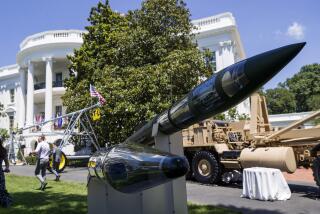U.S. sending missiles, drones to help Iraq fight militants
WASHINGTON — The Obama administration has begun sending Hellfire missiles and surveillance drone aircraft to Iraq to help the government battle an expanding threat from local Al Qaeda-affiliated militants, U.S. officials said, the first such assistance since the American withdrawal from Iraq in 2011.
Responding to an appeal from Baghdad, the administration sent 75 air-to-ground Hellfire missiles this month and is preparing to send ScanEagle surveillance drones early next year to counter intensifying attacks by fighters of the Islamic State of Iraq and Syria, officials said.
Jen Psaki, a State Department spokeswoman, said Thursday that the administration “is committed to supporting Iraq in its fight against terrorism” through the Strategic Framework Agreement, a treaty that provides for U.S. security assistance to Iraq.
The extremist group is expanding its grip across Sunni Arab-dominated territory in western Iraq and has driven suicide bombings and other violence to the deadliest levels since 2008. Militants have terrorized towns and shown an ability to reach into the heart of Baghdad.
At least 37 Christians died in the capital in Christmas Day attacks for which the group was blamed.
The Shiite Muslim-led government of Prime Minister Nouri Maliki has mobilized a force of tanks and infantry to try to attack the group in its stronghold in Anbar province. But the militants have responded strongly, killing more than a dozen soldiers and their division commander during a raid this month on a training camp.
The American surveillance drones and missiles are intended to help Iraqi forces find and destroy some of the extremist group’s camps, U.S. officials said. The Hellfire missiles already have been successfully fired from King Air propeller planes to attack militant camps.
The ScanEagle has more limited range than the armed Predator drones used by U.S. forces in Pakistan, Yemen and elsewhere, so its arrival will leave Iraq short of a solution, analysts say.
But U.S. officials said they have received no request from Iraq for armed drones. Such a request probably would stir protests from Iraqis, who are sensitive to signs that a country viewed as their former occupier is again meddling.
Iraq has not been able to completely rebuild its air force since the U.S.-led invasion in 2003 that toppled longtime ruler Saddam Hussein. Most of Iraq’s aircraft were destroyed during the 1991 Persian Gulf War.
The Obama administration has generally praised the stability of Iraq in recent years. But in recent months, it has voiced concern about the growing strength of the militant groups, a State Department official said.
On Sunday, the State Department issued a statement citing its worries about terrorists “who are seeking to gain control of territory inside the borders of Iraq.”
Though the administration has sought to limit its role in the nearby Syrian civil war, it is especially concerned that Sunni extremist groups in Syria and neighboring Iraq could threaten U.S. allies in the region.
Kenneth M. Pollack, a former U.S. official and longtime Iraq analyst, told a House committee this month that violence in Iraq was “multiplying by orders of magnitude,” and that the country was on a pace to double its civilian deaths in 2013 compared with 2012.
About 8,000 civilians have been killed in Iraq this year, according to United Nations figures.
Pollack, now with the Brookings Institution’s Saban Center, said the regional threat creates a special challenge for Washington because the withdrawal of U.S. forces from Iraq at the end of 2011 has left it with limited influence.
More to Read
Sign up for Essential California
The most important California stories and recommendations in your inbox every morning.
You may occasionally receive promotional content from the Los Angeles Times.











